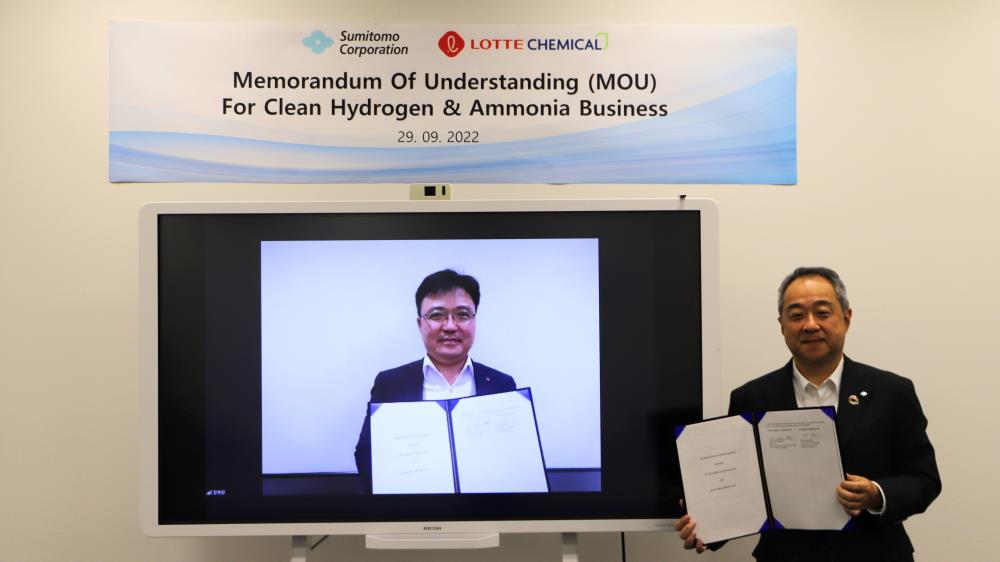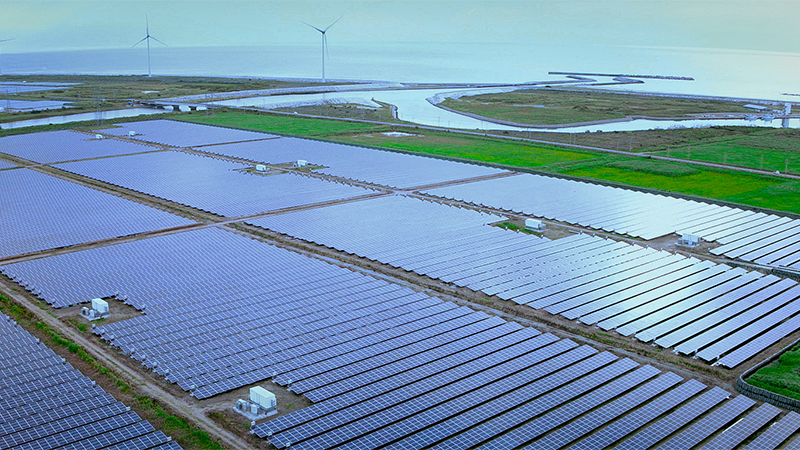Sep. 30, 2022
Sumitomo Corporation
Conclusion of Memorandum of Understanding with LOTTE Chemical for Collaboration in Hydrogen and Ammonia Fields-Accelerating Efforts to Achieve a Decarbonized Society in Japan and South Korea-
Sumitomo Corporation (Head Office: Chiyoda-ku, Tokyo; Representative Director, President and Chief Executive Officer: Masayuki Hyodo) has concluded a Memorandum of Understanding with LOTTE Chemical (Head Office: Songpa-gu, Korea; CEO: Kim Gyo-Hyun) of the Lotte Group in Korea for collaboration in the hydrogen and ammonia fields.
Hydrogen and ammonia are expected to be energy sources that contribute to decarbonization in a wide range of fields, including transportation and power generation, as they do not emit CO2 during combustion. In particular, Japan and South Korea are expected to become large importers of hydrogen and ammonia as they accelerate their initiatives for mixed combustion and mono-fuel combustion of hydrogen and ammonia in the power generation sector, which is expected to create large-scale demand for hydrogen and ammonia in the future.
Sumitomo Corporation and LOTTE Chemical will jointly look into a wide range of business development opportunities for collaboration in the fields of hydrogen and ammonia, including (1) joint investment in hydrogen and ammonia production projects in Australia, Chile, and other regions and the establishment of value chains to Japan and Korea, (2) development of ammonia storage terminals in Japan and Korea, (3) commercialization of new hydrogen and ammonia-related technologies and their deployment in the Japanese and Korean markets, and (4) collaboration in the CCUS (Note 1) field. As part of this cooaborationcollaboration, in August this year, Sumitomo Corporation, LOTTE Chemical, and Syzygy Plasmonics, a U.S. hydrogen technology startup with the world's most advanced photocatalytic technology, agreed to conduct the world's first joint demonstration test of hydrogen production by ammonia decomposition using photocatalyst (Note 2) in Korea.
Sumitomo Corporation considers hydrogen and ammonia as one of the key energy sources in a decarbonized society, and is engaged in the development of a wide range of hydrogen and ammonia-related businesses, including local production for local consumption businesses, large-scale value chain businesses to promote mass production, transportation, storage, and utilization, and investment in new technologies. In the ammonia field, we will also consider and promote an ammonia bunkering business to be promoted in Singapore, design and development of ammonia-fueled ships, and development of infrastructure for marine transportation and storage. Through these efforts, we aim to handle 300,000 tons of hydrogen by 2030 (Note 3), which is approximately 10 percent of the Japanese government's target for hydrogen imports, thereby securing a leading position in Japan.
LOTTE Chemical is a Korean chemical manufacturer with 26 production bases in 22 countries. Under the slogan of "Every Step for GREEN," the company announced its "2030 Vision" in May of this year, announcing investment plans for hydrogen energy, battery materials, and recycled plastics, in addition to its existing petrochemical business. In particular, the company plans to produce, supply, and utilize 1.2 million tons of clean hydrogen by 2030, based on large-scale demand, a large-scale supply network, and eco-technologies.
Sumitomo Corporation and LOTTE Chemical will accelerate efforts to build a sustainable energy system to contribute significantly to the realization of a decarbonized society and mitigation of climate change in Japan and Korea, through the promotion of hydrogen and ammonia related businesses.
- CCUS:Abbreviation for Carbon Dioxide Capture, Utilization and Storage, which means absorption, fixation, and utilization of high concentrated CO2 that is emitted from industrial activities.
- Photocatalyst:A substance that accelerates various chemical reactions and increases the energy of chemical substances via radiated light. Syzygy’s photocatalyst enables the induction of various types of chemical reactions at relatively normal temperatures, which were conventionally induced at a high temperature and under high pressure. The technology can provide the advantages of reduced CO2 discharge from chemical reactions, high efficiency, and lower cost. It is expected that the photocatalyst will enable the wider spread use of hydrogen because it offers an efficient alternative to production methods such as the , since various chemical reactions including electrolysis of water. The photocatalyst enables various chemical reactions including, steam methane reforming reformation of vapor and natural gas, and decomposition of ammonia, which are required both used in theto produce hydrogen production process.
- we aim to handle 300,000 tons of hydrogen by 2030:Figures include hydrogen equivalent of ammonia.

Sumitomo Corporation’s Material Issues
Sumitomo Corporation Group positions “Six Material Issues to Achieve Sustainable Growth with Society” as an important factor in developing business strategies and in the decision-making process for individual businesses. Going forward, we will pursue sustainable growth by resolving these issues through our business activities. This project especially contributes to the following material Issues.
- Inquiries
- Corporate Communications Department, Sumitomo Corporation
- News Release Contact Form



